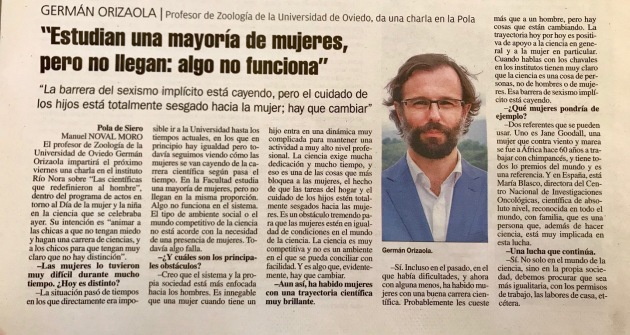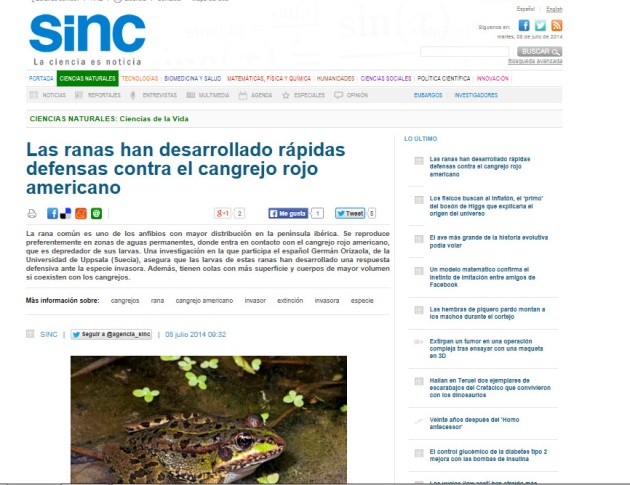This page is not really updated, sorry. Better to check my Twitter account @GOrizaola
LA NUEVA ESPAÑA 23.07.2021
Orizaola: “Chernóbil nos enseña las mejores vías para conservar nuestra fauna”
El biólogo relata en una conferencia su trabajo en la zona de exclusión ucraniana, convertida en “una reserva natural como hay pocas en Europa”

NATURE 15.07.2021
Where I work: Tracking Chernobyl’s effects on wildlife.
Evolutionary ecologist Germán Orizaola Pereda analyses how species have been affected, 35 years after the world’s worst nuclear accident.

CUARTO MILENIO 07.06.2021
Entrevista en “Cuarto Milenio“: La naturaleza se abre paso en Chernóbil.
“En ‘Cuarto milenio’ hemos contado con el privilegio de entrevistar a Germán Orizaola 35 años después del incidente de Chernóbil. Orizaola es uno de los investigadores asturianos que se encuentra en el escenario de la zona cero desarrollando sus estudios sobre la fauna que se ha abierto camino en la conocida como ‘zona de exclusión’”.

AGENCIA SINC 26.04.2021
Entrevista de Adeline Marcos para la Agencia SINC. Hace hoy 35 años, la central nuclear de Chernóbil sufrió un accidente tan grave que obligó a delimitar una zona de exclusión de 30 km, ahora convertida en una reserva natural. Lobos, osos pardos, linces boreales, ranas y caballos, entre otros, proliferan y se adaptan en un área radiactiva, cuyo futuro sigue sin estar claro, según el ecólogo español Germán Orizaola que trabaja sobre el terreno desde hace cinco años.

A HOMBROS DE GIGANTES: RADIO NACIONAL DE ESPAÑA 25.04.2021
Entrevistado por Manuel Seara Valero para el programa “A hombros de gigantes”
Se cumplen 35 años del accidente de Chernóbil. En los primeros momentos se temió que la zona se convirtiera en un desierto estéril asolado por la radiación pero pasado el tiempo se ha transformado en una reserva con gran biodiversidad y en un excelente laboratorio natural para el estudio de la evolución en ambientes extremos. La conclusión parece ser que el hombre es más nocivo para la naturaleza que un desastre nuclear. Hemos entrevistado a Germán Orizaola Pereda, investigador de la Universidad de Oviedo, que lleva estudiando in situ la flora y fauna de la zona desde 2016.

THE CONVERSATION ESPAÑA 23.04.2021
Treinta y cinco años después del accidente nuclear, Chernóbil se ha transformado en un refugio para los lobos, perseguidos por toda Europa.

LA NUEVA ESPAÑA. 21.04.2021
El asturiano que investiga el “paraíso natural” de Chernóbil
El biólogo de la Universidad de Oviedo Germán Orizaola asegura que esa zona de Ucrania rebosa vida 35 años después del accidente nuclear que aterrorizó a toda Europa

THE CONVERSATION ESPAÑA 26.04.2020
El misterio de los caballos salvajes de Chernóbil

English version (The Conversation Australia), French version (The Conversation France).
Re-publication at EL PAÍS, ABC, …
Entrevista en LA NUEVA ESPAÑA sobre nuestro trabajo en Chernobyl y mi participación en “El Club de la Ciencia-Oviedo” 2019, con la charla “Nos quedamos sin sidra”.
(Interview at the local newspaper “La Nueva España” about our work in Chernobyl and my participation at “El Club de la Ciencia-Oviedo” 2019 talking about climate change and the risks for the local cider production.

Article at THE CONVERSATION España (in Spanish) and THE CONVERSATION UK (in english) about the situation of Chernobyl wildlife 33 years after the nuclear accident.

Interview at “La Nueva España” about he International Day of Women and Girls in Science #11F2019
Entrevista en “La Nueva España” sobre mujer y Ciencia, relacionada con la celebración de charlas en colegios e institutos durante el Día Internacional de la Mujer y la Niña en la Ciencia #11F2019

Article about my talk “Humanos y radioactividad: la fauna de Chernobyl 30 años después de la catástrofe”, at Mieres Culture Centre (Asturias), 19 September 2018, published at La Nueva España.
Link here

I was interviewed at Onda Cero weekend program “Por fin no es lunes” by América Valenzuela and Jaime Cantizano on 29 April 2018 about our work on the effects of the Chernobyl nuclear accident on wildlife.
Full audio of the interview (in Spanish) here

Our work with Chernobyl frogs was featured by “Frogs and Friends” web on 26 April 2018.
“Chernobyl frogs”

I was interviewed on 9 March 2018 by Emil Nilsson (Biotopia) for a Naturpodden special podcast during the 2018 Uppsala Science Fair “Uppsala SciFest” on the effects of 1986 Chernobyl accident on wildlife.
See the full interview here: The (radioactive?) frogs of Chernobyl

I was featured on 31 December 2017 at La Nueva España talking about my return to Spain as a Senior Researcher within the “Ramón y Cajal” program.

Our work with Chernobyl treefrogs was featured at two magazines published by Uppsala University during the autumn.
UNIVERSEN “4 frågor till Germán Orizaola” LINK

NEW HORIZONS “The frogs are thriving in Chernobyl” English version (LINK), Swedish version (LINK)

My work, with Pablo Burraco (Doñana Biological Station EBD-CSIC, Spain), on the effects of chronic low-dose radiation in the amphibians living in the Chernobyl Exclusion Zone, Ukraine, was covered by América Valenzula (@A_Valenzuela) at “El Independiente” spanish newspaper. See here

Listen to my time at SlightlyEvolved podcast with Toby Fountain, talking about “The frogs of Chernobyl“. And for more podcasts in the series, go to its Souncloud webpage. Highly recommended.

My recent paper with Bruno Carreira et al. “Warm vegetarians? Heat waves and diet shifts in tadpoles” Ecology 97, 2964-2974 was featured at
El Mundo (link)

Agencia SINC (Spanish, English), EurekAlert (link), Science Daily (link), Live Science (link), Nature World News (link), n-tv.de (link), La Razón (link), Science et Avenir (link), Forskning.se (link) and others.
Popular Science article “El asesino de anfibios” (in Spanish) about emergent diseases in amphibians, published at PRINCIPIA, October 2016.

My recent paper with Anssi Laurila “Developmental plasticity increases at the northern range margin in a warm-dependent amphibian” Evolutionary Applications 9, 471-478 was featured at
Agencia SINC (Spanish, English)

EurekAlert, Phys.org, ScienceDaily, AlphaGalileo, CienciaXplora, Ecoticias, Noticias de la Ciencia y la Tecnología, AmphibiaWeb blog.

My letter in SCIENCE with Ana Elisa Valdés “Free the tweet at scientific conferences” and our extended opinion piece (in Spanish) at Agencia SINC were featured at:
Science Careers here

Uppsala University magazine UNIVERSEN here

Noticias de la Ciencia y la Tecnología here
Mirada profesional here
Our Ecology paper “Transgenerational phenotypic plasticity links breeding phenology with offspring life-history” has been featured by:
Spanish Information and Scientific News Service SINC (english version), EurekAlert – AAAS, Phys.org, ScienceDaily, NatureWorldNews, Design&Trend, BrightSurf.com, Ecoticias blog, El Imparcial and La Razón.
A comment on our Ecology and Evolution paper “Morphological and life-history responses of anurans to predation by an invasive crayfish: an integrative approach” appeared on Froglog 111, 81-82.
Our Ecology paper “Rapid evolution of constitutive and inducible defenses against an invasive predator” has been featured by:
Ecological Society of America blog EcoTone here,
Spanish Information and Scientific News Service SINC here (english version here)
Agencia EFE (EFE verde here and EFE Futuro here), La Vanguardia here, La Razón here, EurekAlert – AAAS here, Phys.org here and Ecoticias blog here.
A commnet of this article also appeared in FrogLog 112, 60-61.


